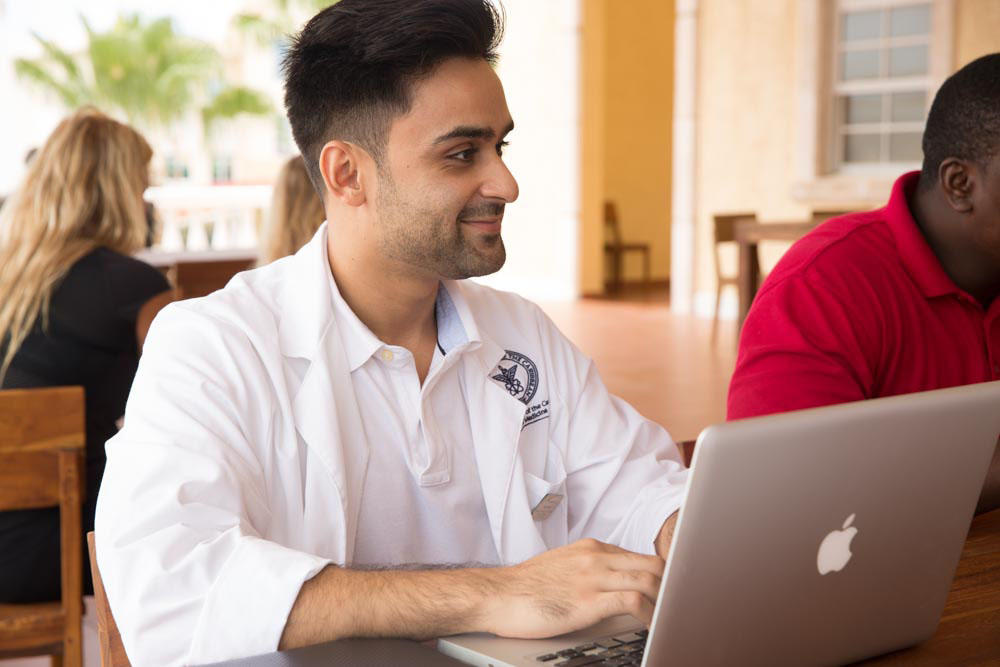Students interested in becoming a physician know that getting into an accredited four-year medical school—such as the American University of the Caribbean School of Medicine (AUC)*—is the first big step. Students also know that getting into medical school is not easy. Even schools with the reputation of being one of the easiest medical schools to get into pose challenges. All medical schools have sets of requirements for admission—prerequisite classes, good grades, an undergraduate degree, medical experience, and a high score on the Medical College Admission Test® (MCAT®).
Many prospective medical students want to know the answers to these common questions: How hard is it to get into medical school? How do I get into medical school with a low GPA? Every medical school is unique, and methods of evaluation for admission vary from school to school. Some medical schools are known for strict standards and minuscule acceptance rates, while others are known for being more generous with student admissions. Many factors go into whether a school is considered “hard” or “easy” to get into, and not all of them rest with a student’s academic and application performance.
The ins and outs of medical school admission—including how schools may be considered “easier” to gain admission or among the easiest medical schools to get into—are discussed below. Keep in mind, however, that no medical school is easy to get into. They all require promising students capable of achieving success.
What Is Meant by Medical Schools that Are Easy or Hard to Get Into?
Statistically speaking, all medical schools are hard to get into, even those that have been categorized as the least competitive medical schools. Data compiled annually by the Association of American Medical Colleges (AAMC) shows that in the past year just 36.3 percent of applicants succeeded in gaining admission to a United States medical school—and this despite the fact that each student applied to an average of 18 medical schools!
In 2021, the 62,443 students who applied 1,099,486 times to medical schools were exceptional—they carried a mean grade point average (GPA) of 3.59 (out of 4.0) and scored an above-average 505.9 on the MCAT. But the 22,666 matriculants (accepted students) were just a bit better: they had a mean GPA of 3.74 and an average MCAT score of 511.9. So technically, no medical school should be categorized as being one of the “easiest med schools to get into.”
Still, many medical schools get categorized as being either one of the easiest medical schools to get into or the hardest to get into. This happens because of such factors as acceptance rate, average GPA, and average MCAT score. These factors tell part of the story, but the ease or difficulty of matriculation is also influenced by such things as a student’s determination, location, personal connections, personal preference, and verbal and written skills; as well as by the school’s location, popularity, reputation, and type of funding—state or private.
Medical School Acceptance Rates
Typically, medical schools that admit the lowest percentages of applicants are considered hard to get into; and schools that admit the highest percentages of applicants are considered to be among the easiest med schools to get into. That is not always true, however, as many applicants may avoid schools with more competitive or stricter entry requirements, increasing the number of applicants—but not the number of matriculants—at “easier” schools. Admission percentages result from simple math: Some schools have few openings but a large number of applicants, while other schools may have more openings but fewer applicants. Both cases skew admissions toward “hard” or “easy” without any other consideration.
With medical schools in the United States, acceptance rate can be affected by whether applicants are in- or out-of-state. For international medical schools such as AUC—which is located on the Caribbean island of Saint Martin—there is no such thing as an “in-state” applicant.
When deciding where to apply, it is important for students to know a medical school’s acceptance rate as well as the average GPA and MCAT scores for matriculants. Many medical schools eliminate applicants below a certain GPA or MCAT score and continue paring down from there. Most students target medical schools where their GPA and MCAT score match the average matriculant.
Students may also apply to “reach” schools, where their grades and scores are lower than the accepted average, or to “safe” schools where their GPA and MCAT are above the average matriculant. Students may also consider medical schools—such as AUC—that take a more holistic approach to admissions. This process considers an applicant as a whole person rather than a mere set of grades and scores.
Holistic admission looks at a student’s adaptability, critical judgment, intellectual and social maturity, life experiences, and volunteer work, as well as graduate school performance when applicable. A holistic approach does not discount grades and test scores, but it does allow for more leniency in academic performance.
When considering a medical school, many students look ahead to post-graduate internships and residency programs. Some of the more prestigious medical schools may influence the attainment of a residency, but residency placement depends more on a student’s clinical competency rather than where the student was educated. AUC graduates have a strong history attaining residencies in internal medicine or other specialties. AUC had a 92 percent first-time residency attainment rate for 2020-2021 graduates.
Reapplication and Conditional Acceptance
It is disheartening for students who do not gain acceptance to medical school, but it is not the end of the story. Many of the students who are not at first accepted keep trying and reapply. Students who reapply are more aware of their shortcomings during the first round of applications, and take steps to eliminate them.
They may retake the MCAT—up to seven times—or bolster their Curriculum Vitae (CV) by working in the medical field or attending a health care master’s program or postbaccalaureate premedical program. The famous “gap year,” usually taken by students as a breather between university and medical school, is not always voluntary—and it is often more than one calendar year.
Some students receive conditional acceptance to medical school, meaning that with a little extra effort and preparation, they will be accepted. These students must attend a postbaccalaureate premedical program specified by the particular medical school. At AUC, this is the Medical Education Readiness Program (MERP). MERP is a 15-week program that provides additional academic preparation and paves the way for achievement in medical school. Successful completion of the program turns a conditionally accepted student into an accepted one.
The American University of the Caribbean School of Medicine trains tomorrow’s physicians, whose service to their communities and their patients is enhanced by international learning experiences, a diverse learning community, and an emphasis on social accountability and engagement. Take the next step toward medical school: apply for admission to AUC.
Related resources:
- Medical School Requirements
- Should I Go to Medical School?
- Medical School Admission FAQ’s
- MD Program
*American University of the Caribbean School of Medicine is accredited by the Accreditation Commission on Colleges of Medicine (ACCM, www.accredmed.org), which is the accreditor used by the country of St. Maarten.





